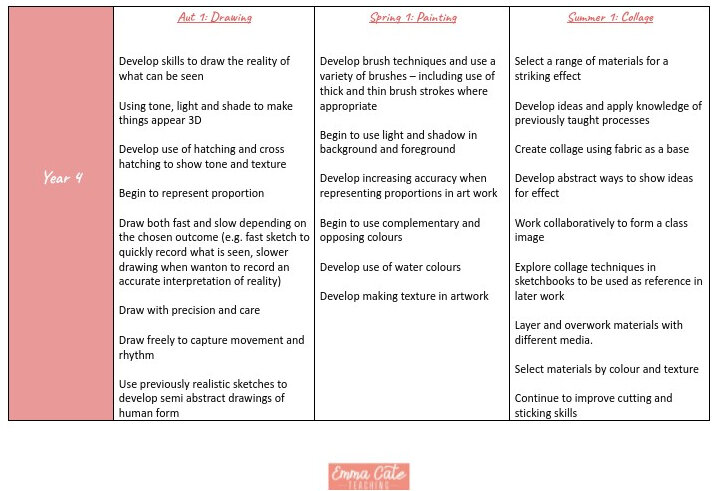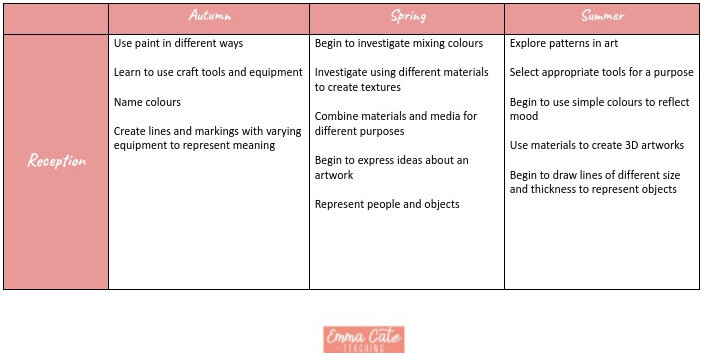Designing an art curriculum: Key Skills
In the first part of this series I discussed the broad strokes of the process I went through when re-hauling the art curriculum at my last school as Art Lead. In this post I am going to focus in on the Skills Progression aspect of the curriculum.
Historically, it can be argued that art in Primary has been seen by some as a fluffy activity. It is my feeling that art should have a meaningful place in the curriculum and be more than a quick lesson on Vincent Van Gogh’s Sunflowers. As mentioned, I discuss this in much more detail in my previous blog.
Skills progression has an important part to play in designing a well rounded art curriculum but what does the term ‘skills progression’ actually mean?
In its most basic form it is essentially advancing pupils through a series of simple steps that becomes progressively more advanced in order to develop proficiency in more complex skills. However, in order for skills to be progressed, we must ensure that alongside a well thought out series of steps that ultimately ends up as a ‘skills progression’ document we are also enabling situations and giving pupils time to implement learning, using subject knowledge and best practice in such a way that allows pupils to embed and demonstrate taught skills. Skills progression should not be used in isolation and should be the basis for creating a rich curriculum via which said skills can be taught.
In order to achieve this, as teachers, we need to see the complete picture (art joke) and not just the individual strokes the children are making. In this sense progressing a pupil’s skill isn’t about arbitrarily making steps more difficult, it is thinking about that complete picture.
One of the aims for teachers is to develop skills that transfer into independent work. The purpose of skills progression document is not to act as a checklist to ensure something has been taught and can be ticked off; but rather should be seen as a transfer sheet or in other words a child transferring or applying that taught skill into their own creations.
When thinking about the teaching of the skills themselves it is important to break the skill as a whole down into smaller manageable components. This process can be referred to as chunking.
Image taken from The Learning coach.
Fernand Gobet defines it as:
A chunk is meaningful unit of information built from smaller pieces of information, and chunking is the process of creating a new chunk. Thus, a chunk can be seen as a collection of elements that have strong associations with one another, but weak associations with elements belonging to other chunks. Chunks, which can be of different sizes, are used by memory systems and more generally by the cognitive system. Within this broad definition, two further meanings can be differentiated. First, chunking can be seen as a deliberate, conscious process. Here, we talk about goal-oriented chunking. Second, chunking can be seen as a more automatic and continuous process that occurs during perception. Here, we talk about perceptual chunking.
When looking at the National Curriculum for Art in Key Stage One it states that pupils should be able:
to develop a wide range of art and design techniques in using colour, pattern, texture, line, shape, form and space
Obviously, that is very broad! As I referenced in my previous blog, “some of the statements are so broad it can be difficult to think about how that looks in terms of progression and learning.” And so in the skills progression map you can see that I have thought carefully about each component part of that very broad skilland broken down what that would look like in Y1 and Y2 in terms of skills progression across multiple mediums. In doing so pupils are able to create meaningful units of information that have been built upon those smaller pieces of information that Gobet refers to.
When thinking about developing skills in ‘line’ I have further broken this down into smaller component parts across KS1 such as: ‘begin to control lines (colour inside lines)’, ‘draw lines of different sizes and thickness’, and ‘use a variety of lines to convey meaning’ among others. What is important is how those individual smaller component parts fit together to form a meaningful whole that creates a clear skill that can be used independently in artistic practice. The next stage is taking those parts and putting them together to combine the skill into an artistic sequence. At this stage, the skills progression goes hand in hand with the medium-term planning and will be the next in the series.
This map is separated into half terms with a focus on one artistic medium per half term. The rationale behind this can be found in the first blog.
Reception Year is covered in the map but is laid out differently for a variety of reasons. Firstly, the EYFS framework differs to KS1 and KS2. Secondly, due to the nature of EY the children will be applying these skills throughout the year; however in each term Reception teachers would explicitly teach the skills as laid out in the map. That is not to say that the children would only use them at those times.
You can find the Skills Progression Map below. It is very specific to the needs of a particular cohort of children and their relative starting points. As should be the case in schools it is very much a working document and is subject to change. I am more than happy for other schools to use it as a starting point if they wish as I believe in these unique and trying times we should all be helping each other. All I ask is if you do use please remember to adapt for your context and credit would be lovely.








One of the most enjoyable things about art is how subjective it is. No two opinions on a piece of artwork will be the same. Teachers often talk of Reading for Pleasure. I am a strong advocate of Viewing Art for Pleasure. Responding to art is one of life’s great joys. The key here is discussion. Discussions around artworks need to be planned well within a broader curriculum that emphasizes vocabulary, language, and the value of talk. In its simplest form, this could just be as simple as a pupil saying what they can see in front of them but with careful modelling and the right school culture, it can lead to powerful discourse in the classroom.